 |
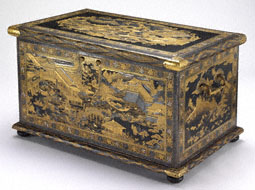
 |
 |
The Mazarin Chest, Japanese, about 1640
|
 |
 |
|
This exhibition presents examples of Japanese lacquer objects from the Victoria and Albert Museum in London. Made in Japan—some specifically for export to Europe—these objects were popular among wealthy European collectors from the 17th to 19th centuries. The art form has had a major impact on both the fine and decorative arts.
At the heart of this exhibition is the Mazarin Chest, one of the most significant and beautiful examples of Japanese export lacquer to have survived, and a highlight from the collection of Japanese art at the Victoria and Albert Museum. Made for European patrons, the chest features scenes from Japanese literature and is decorated in a traditional Japanese lacquer technique called makie ("sprinkled picture"), in which gold or silver powder and flakes are sprinkled over successive layers of lacquer before it dries.
|
 |

 |
 |
Detail from front panel of the Mazarin Chest showing use of gold makie technique.
|
 |
 |
The Mazarin Chest is extraordinary for its size and the richness of its lacquer decoration. Although the quality of the lacquer is similar to that of the finest pieces made for the domestic Japanese market, the chest's shape and its imagery, which includes pictorial scenes—often with human figures not typically represented on domestic objects—indicate that it was made for export.
Made in Kyoto, the Mazarin Chest was shipped to Europe and owned by a series of prominent collectors before it was acquired by the Victoria and Albert Museum in 1882. Its name is derived from the Mazarin-La Meilleraye coat of arms depicted on the key, which indicates that it was once owned by a member of that French family.
|
 |
 |
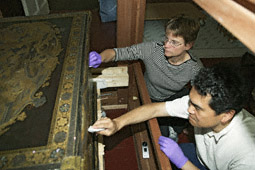
 |
 |
Victoria and Albert Museum conservator Shayne Rivers and Japanese lacquer conservator Yoshihiko Yamashita at work conserving the Mazarin Chest
|
 |
This exhibition marks the completion of an international conservation and research project on the Mazarin Chest that was supported by a major grant from the Getty Foundation, with contributions from the Toshiba International Foundation and the Victoria and Albert Museum (V&A). Before conservation treatment began in 2005, the chest was in poor condition due to centuries of exposure to light and changes in temperature and humidity.
In addition to stabilizing the chest and its decorations, the conservation project sought to develop a new approach to the conservation of Japanese lacquer that incorporates both Western and Japanese conservation values. Western conservation ethics emphasize minimal intervention and the reversibility of treatments, while traditional Japanese conservation seeks to preserve the cultural continuity of objects by using materials and techniques similar to those used at the time of manufacture. Japanese conservator Yoshihiko Yamashita worked with the V&A's conservation team to train them in traditional Japanese restoration techniques. It was the first time a Japanese conservator traveled outside Japan to treat an object and collaborate with another institution's staff, setting a new standard for the conservation of Japanese lacquer objects held in Western collections.
Learn more about the Mazarin Chest conservation project. (Links to V&A Web site.)
|
 |
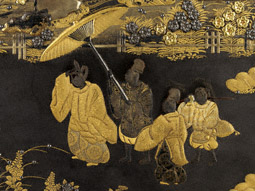
 |
 |
Detail of the Mazarin Chest depicting Genji walking under an umbrella held by his servant
|
 |
 |
|
|
 |
The front panel of the Mazarin Chest is decorated with various scenes referring to different chapters in Genji monogatari (The Tale of Genji), a masterpiece of Japanese literature written in the early 11th century by an aristocratic woman. The tale recounts the life, love affairs, and political fortunes of Prince Genji and his immediate successors. Considered to be the world's first novel, the book evokes the rich court life of medieval Japan. Although Westerners would have had little if any knowledge of the story in the 1600s, the Japanese craftsmen knew that foreigners enjoyed images of human figures, and seem to have drawn inspiration from their own culture's most popular stories.
This scene shows Genji walking beneath an umbrella held by his servant Koremitsu. The image refers to a scene in the novel in which Genji goes to visit Suetsumuhana, a long-neglected love, and murmurs as he approaches, "Now that I am here, I myself shall seek her out through her trackless waste, to see whether all these weeds have left her as she was then." (The Tale of Genji, by Murasaki Shikibu, translated by Royall Tyler. New York: Penguin
Classics, 2001.)
Learn more about the design elements on the Mazarin Chest. (Links to V&A Web site.)
|
 |
 |
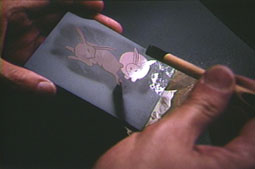
 |
 |
A craftsman applies decoration to a lacquer object.
|
 |
 |
|
The process of creating lacquer requires time and skill. First, a wood core is prepared from pine or cypress seasoned for as long as 50 years. After two base coats of lacquer, linen fabric is adhered to obscure joints and create a uniform surface.
Twenty to twenty-five layers of lacquer are then applied to slowly build up the surface. Each coat is cured in a drying cabinet and polished carefully with charcoal and polishing stones. The first layers are mixed with progressively finer clay to hide the texture of the fabric layer. Lacquer with black pigment is then applied in progressively finer coatings using brushes made from the hair of young women. The final layers require the finest quality lacquer, which is filtered many times to remove impurities. The final surface is then ready for decoration.
The Japanese have developed many techniques to create a wide variety of surface decoration. Makie ("sprinkled picture"), in which a black lacquer surface is decorated with gold and silver, is among the most celebrated. Other metals, shell, and colored pigments can also be sprinkled on or set into the surface. Created in many steps, the decoration adds about 15 more layers to the lacquer, to arrive at a rich surface that sets makie apart from other types of lacquer decoration.
|
 |
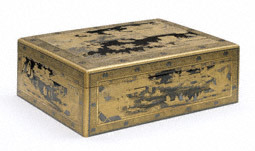
 |
 |
The Van Diemen Box, Japanese, 1636–1639
|
 |
 |
|
|
 |
Also on view in the exhibition is this box, which was made to order in Kyoto and uses the most expensive and elaborate lacquer techniques. The underside of the box's lid is inscribed with the name Maria van Diemen, wife of Anton van Diemen, the governor-general of the Dutch East Indies from 1636 to 1645.
This box is unusual in that it was created for export, but takes the form of a traditional Japanese document box. The scene on the top of the lid refers to Prince Genji's coming-of-age ceremony from The Tale of Genji. (View the decoration on the lid of the box.) The ox-draw cart at the lower right corner of the lid refers to Genji being brought to the emperor, who is shown seated on the porch at the upper left corner.
|
 |
 |

 |
 |
Incense Cabinet with Birds and Flowers Representing the Four Seasons, Japanese, late 1600s–early 1700s
|
 |
Included in this exhibition are a selection of small Japanese lacquer boxes and cabinets from the Victoria and Albert Museum, which provide history and context for this important type of Japanese art. Many of these objects were made in Kyoto, Japan's former imperial capital, and transported to Deshima, a small island in Nagasaki harbor, for shipment to Europe by Dutch merchants.
Small portable cabinets like the one shown above contained the elements for a game that entailed identifying different types of incense (kō). The ritual known as kōdo (the way of incense) became an important facet of Japanese culture. During the 1600s and 1700s an incense game, kō awase, reached the height of popularity among the upper classes. European collectors may not have been familiar with this tradition; nevertheless, they admired these small works for the fine quality of the lacquer decoration. This cabinet is nearly identical to one in the collection of Queen Marie Antoinette (French, 1755–1793)
and may have been owned by her.

All images courtesy of and © V&A Images/Victoria and Albert Museum, London
The J. Paul Getty Museum is grateful to the Victoria and Albert Museum, London, for the generous loans from its collection and to the Kyoto National Museum, the Suntory Museum of Art, Tokyo, and the Yomiuri Shimbun, Osaka, for their assistance in organizing the exhibition. These works were recently included in a larger exhibition on Japanese lacquer at the Kyoto National Museum and the Suntory Museum in Tokyo. Learn more about that exhibition on the Kyoto National Museum's Web site (find it under "Past Exhibitions"): Export Lacquer: Reflection of the West in Black and Gold Makie.
|
 |







